Thanks for the recommendations guys I'll look into them, ideally after a 9" peel as that's the size of pizza I tend to make and it can double up as a turner as well.
I'd wanted a pizza oven for ages and initially looked into the Ooni ovens but after a lot of research and the help of the Forno Bravo fourm decided to have a go at building one.
The first challenge was space and size, the reason I was interested in the Ooni oven was it's compact size. I didn't think I had room for a full blown brick built oven, which start around 28" internal size, far to large for my tiny garden. I then found out about cast ovens (not these perlite ones all over youtube, they are bad) which allow for smaller sizes and easier building but there are trade offs.
One of the main points to having a brick oven is so you can use the retained heat after firing for pizza to use as a regular oven. Large ovens can stay hot enough to cook in for several days.
The down side to a smaller oven is less mass so it wont retain heat for nearly as long, as well as fitting less inside. There is also a problem of chimney placement, traditionally the chimney is placed in front of the chamber as this draws hot air around the dome, down then out of the chimney. This circulation of hot air radiates heat onto the floor of the oven which is essential for cooking, especially for pizza.
One plus point of a smaller oven is it heats much quicker and uses far less fuel.
In the end I had to trade off some functionality for size, I wanted to use fire bricks in the built to try and achieve some level of retained heat cooking and went down the unusual route of using fire bricks and clay casting to build an oven with a 22" internal size, about as small as you can go with a brick oven and about as small as you'd want to go for an outside oven.
Starting with the fire bricks. I cut them to shape with a diamond blade on a grinder. Hard work even with the grinder as they are very tough.
Ideally cut with a wet saw as the dust is full of silicate and other nasties, very bad for the lungs.
If it was going to be a full brick build the outer bricks would also need to be bevel cut so they are close fitting to avoid heat loss. As I was using clay I could fill the voids with it and it saved a lot of work.
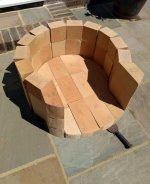
I made a base with concrete blocks which I plan on cladding later to smarten up. The oven then sits on 4.5" of insulation. Consisting of a insulated cement board, perlite/cement mix, and finally 1" of calcium silicate board. This floor insulation is critical, if not used heat loss through the floor bricks would make the oven practically useless. (this is one of the reasons why the perlite youtube ovens fail)
The outer fired bricks of the oven are set in place with a clay, lime, stainless steel reinforcing needles and cement mix. This is also the same mixture that will create the dome.
I started on the mould for the dome with polystyrene and sand
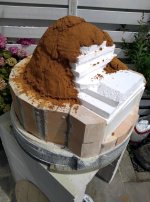
With the dome mould done and the chimney temporarily in place, I covered it in cling film so I can use it while casting the dome to get a perfect fit.
First trade off of this small oven design, I brought the chimney as far forward as possible, ideally it would be further forward for the reasons mentioned above but the oven size limited this.
Will have to wait and see how it performs.
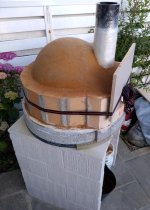
The sand dome mould was then covered in newspaper and 3" of the clay mix was compacted over it. once the clay mix was dry enough the sand/polystyrene can be removed leaving the formed dome set in place.
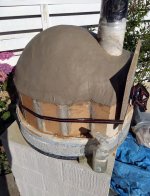
The whole oven was then covered with 2" of ceramic fibre insulation blanket, another critical step to help retain heat.
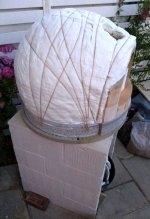
The blanket was then covered with a perlite, vermiculite, lime, reinforcing needle, cement mix to add strength and a further layer of insulation.

And this is where the project came to a halt. It was no where near finished but was nearly at the stage where it could be used. It had been a few months work up to this point and my enthusiasm was starting to dwindle, It had been much harder work than I had anticipated and the stresses of the pandemic and lock down where starting to show on myself and family.
So I wrapped the project up and took a step back.
Fortunately because of the amount of cement and thus water in the build it would take many months before it was dry enough to fire up.
You can dry them out faster by starting small controlled fires but there is a risk of heating the dome too fast tuning all that water to steam, cracking the dome which potentially could cause huge heat loss issues. I needed a break and was happy to wait a few months for it to dry naturally, that few months turned into nearly 2 years.
My interest was sparked again when a friend recently got an Ooni and was telling me about it, I'm really glad it has. It's great fun firing up the oven with a beer and it does make excellent pizza.
I've had a busy weekend and made a indoor pizza and the difference is huge.
Thankfully it seems to be performing well too. It does take at least 1 hour to get the floor bricks up to pizza cooking temp but I don't think that's to bad, I char the peppers and cook the toppings in that time.
In hindsight if I where to build it again I would lengthen the entrance to bring the chimney forward and reduce the dome height by a couple of inches. that would help to heat the floor slightly quicker.
It also seems to be retaining heat well. I made a quick door and cover for the chimney and the next morning after making pizza the oven was still hot enough to cook in, though I suspect I'll only get 24 hours max out of it. Trade off for it's size but I'm happy with that.
I've cooked a banana loaf and pancakes the next morning.
All that's left is to make a proper door and chimney plug and make the thing look respectable

I plan to clad the lower base, maybe with tiles or stone and cover the whole dome in a mosaic style
Something like this
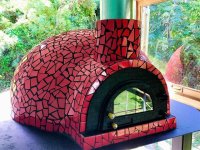
I might get it finished in the next 2 years












 It really is.
It really is.

